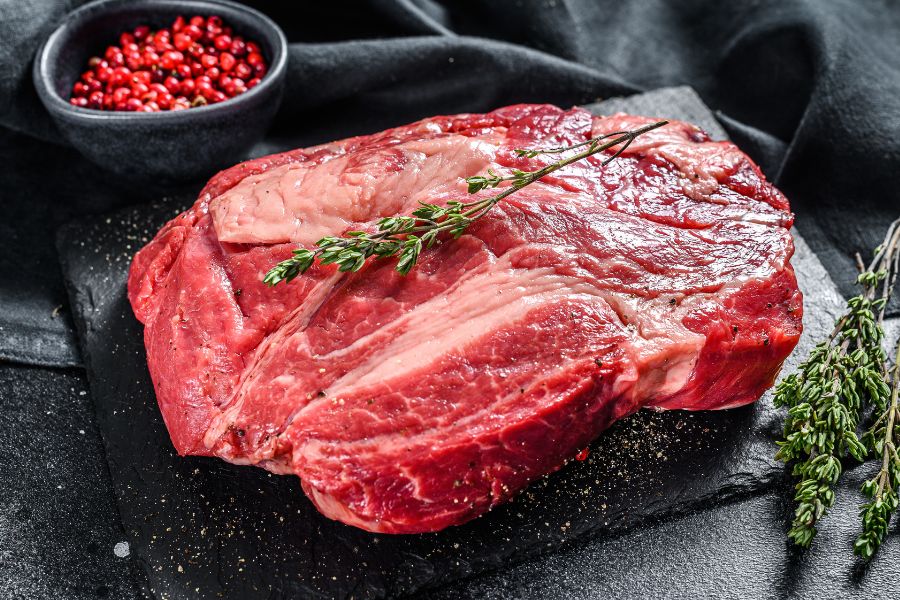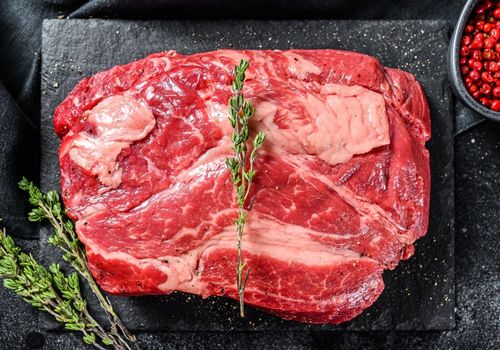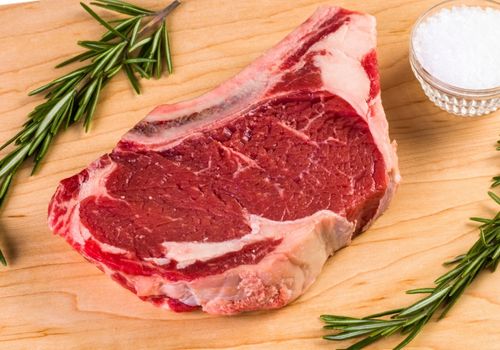The chuck eye and ribeye are both delicious cuts of meat. The chuck eye shares the same great flavor as the ribeye. However, while the chuck eye is taken from the 5th rib, the ribeyes are taken from the 6th to 12th ribs. The ribeye clearly stands out in the taste department.
The ribeye is one of the steaks I enjoy cooking because of its tenderness. That’s not to say that the chuck eye steak isn’t a worthy competitor because it is. I’ve had these steaks on my plate and on my grill many times. So, join me as I compare these meat cuts in detail.

When discussing the differences between chuck eye and ribeye, it’s important to pay special attention to how they look, taste, price, and preparation time. With that said, let’s compare these beefy steaks.
At first glance, the chuck eye steak looks like a ribeye. This piece of meat is sufficiently marbled and covered with streaks of fat.
By the way, marbling is a term describing the amount of fat present on a cut of steak.
From experience, I found that steaks with better marbling often taste better.
Moreover, a cut of chuck eye steak is typically 1 to 2 inches thick.
Rib steaks also look well-marbled. You’ll typically notice more marbling on a ribeye than a chuck eye steak. It’s no surprise that this tender meat tastes juicy and beefy.
Pro tip: when shopping for a chuck eye or ribeye steak, select the cut with a lot of marbling.
Related Reading
Although this steak is cut from the chuck primal, it shares a portion of the longissimus dorsi muscle found on the ribeye, which gives the meat a tender texture.
However, most of the meat on a chuck eye steak comes from the steer’s frequently exercised neck and shoulder region.
Like the chuck roast, you should heat the chuck eye steak slowly on low heat to guarantee an even cook.
Remember, the steak will feel tough and rubbery if you overcook it. Read our guide on grilling a chuck-eye steak for more tips.
Comparatively, the flavor of ribeye is also very delicate and flavorful. Because of the even marbling, the steak has one of the most delicate, silky textures you can find.
More marbling means more caramelization producing a sweeter, beefy flavor. Typically, the meat at the end of the ribeye feels tougher, while the meat at the center of the ribeye is nearly as tender as a filet mignon cut.
A ribeye cut costs more than a chuck eye steak. The premium ribeye cut tastes more delicious and is the gold standard among customers.
Compared to chuck eye steaks, the ribeye is more expensive. Customers prefer the premium ribeye cut because it is more flavorful.
The cost of rib steaks vary depending on the store. That said, the average price range of a ribeye steak is $12 – $20. However, some cuts are extra-expensive, costing over $100 per pound.
On the other hand, the chuck cuts are a more economical cut of beef. You can find chuck eye steak in stores for $5 – $10 on average. Chuck eye steaks are an excellent bargain if you want a cheap alternative to ribeye steaks.

Both the chuck eye and ribeye have similar cooking times. The thickness of the cut plays a significant role in the preparation time.
For instance, a cut of chuck eye cooked on medium-high heat will take roughly 10 minutes to cook. On the other hand, a 1-inch or 1.5-inch ribeye cut will take 9 to 12 or 12 – 15 minutes to cook.
We strongly advise cooking to temperature rather than time because the precise cooking time will vary depending on several factors.
I recommend using a meat thermometer to check the internal temperature of the beef. The meat’s temperature generally indicates its doneness.
When checking the meat’s temperature, insert the thermometer through the side of the cut and tip in the center. Ensure you don’t touch the bone or fat.
Then, remove the steak from the fire when the temperature is 5°F lower than your preferred level.
This is because the meat will continue cooking after you remove it from the pan, and the temperature will continue to rise.
Here’s a chart highlighting the ideal internal temperature of chuck eye and rib steaks:
Meat Doneness Level | Recommended Internal Temperature |
Rare | 120 - 130°F |
Medium-rare | 130 - 135°F |
Medium | 135 - 145°F |
Medium-well | 145 - 155°F |
Well-done | 155 - 165°F |
Attribute | Chuck Eye | Ribeye |
Calories (per 4-oz) | 240 calories | 320 calories |
Fat & Protein | 65% Fat and 35% Protein | 76% Fat and 24% Protein |
Recommended Doneness | Medium-rare | Medium-rare |
Average Price | $12 - $20 per pound | $5 - $10 per pound |
Chuck eye steak, also referred to as the poor man’s ribeye is cut from the upper shoulder of the cow — also known as the chuck primal — located around the steer’s fifth rib. On the other hand, the ribeyes are taken from the sixth to twelfth ribs.
Chuck eye steaks taste delicious when grilled at low or high temperatures. Moreover, this flavorful cut of meat contains a few inches of the longissimus dorsi muscle, which makes it taste tender.
Chuck eye steaks can be a juicy, tasty cut, just like the ribeye steak, as long as you cook it medium-rare or below.
The ribeye is one of the most premium cuts of steak you can devour. This steak is cut from the beef rib primal cut located close to the steer’s twelfth rib.
The ribeye steak is tasty and tender, with the right amount of fat.
Related Reading
There are two types of rib eye steaks: boneless and bone-in. Although the bone adds extra flavor and moisture to the beef, it can make the steak tricky to prepare.
Fortunately, you can buy boneless ribeye if you don’t want to face all that hassle. The muscle responsible for the ribeye’s famous tenderness is the longissimus dorsi.
The longissimus dorsi is a long, delicate muscle that extends from the steer’s hip to its shoulder blade.
This part is so delicate because the region doesn’t get exercise, so the muscles don’t toughen like the muscles in the chuck area.
In addition to being delicate, this muscle has a significant quantity of intramuscular fat—also known as marbling— which gives the steak a ton of moisture and flavor.

The chuck eye steak is unquestionably a good cut. As discussed earlier, the chuck steak tastes like the ribeye but has less marbling, which means it’s not as juicy as a ribeye.
Don’t let that discourage you; it’s still a tasty cut of beef. A bonus is that the chuck eye is also more affordable, so you can savor the taste while saving a couple of bucks.
“Poor man’s ribeye” is a common term used by butchers when describing the chuck eye steak, which is cheaper and tastes like a ribeye. The chuck eye steak has a similar beefy flavor as the ribeye. However, the ribeye feels more tender.
By now, you probably know that the ribeye is the winner of this taste contest. However, if you’re not willing to spend that much on the ribeye, buy the chuck eye instead. You can’t go wrong with the chuck eye, and you’ll be guaranteed a juicy and tasty steak. However, it’s not as delicious as ribeye.